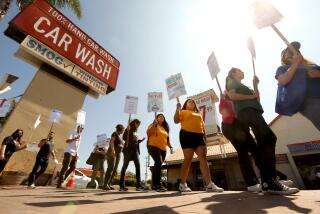Van Nuys DWP Pickets Vow to Stick Together
- Share via
VAN NUYS — Ninety-nine years after President Grover Cleveland declared Labor Day a national holiday to honor workers, striking city utility employees say it’s no picnic being in a tug of war with their City Council bosses over money and working conditions.
Instead of beach parties and barbecues this Labor Day, the strikers face lost wages, the scorn of passersby and the grinding monotony of hours on the picket lines. But, like other union members before them, the workers are vowing to stick together despite their hardships and the tough times suffered by unions in general since the 1970s.
“Nobody can afford this strike,” said John Timmerman, 28, a lineman and strike captain. “But no one can afford not to be out here. If we quit, the City Council is just going to shove us aside.”
Timmerman was on the picket lines at the Department of Water and Power’s service headquarters in Van Nuys. He and dozens of other striking workers of the International Brotherhood of Electrical Workers Local 18 gathered at the facility’s entrance on Saticoy Street at Van Nuys Boulevard. It was Friday afternoon and the group was spending its second day picketing in 90-degree-plus heat, far from union and management brass downtown. Two days later, the strike would still be on.
“All we need is one week of 100-degree temperatures and this city will collapse,” one man said. The Van Nuys facility, which normally employs between 300 and 400 workers, is where San Fernando Valley repair crews are headquartered. Teams on are 24-hour standby to patch together power systems that inevitably fail under the load of hot-weather electricity demand.
DWP workers seldom receive much attention because water and electricity are, with rare exceptions, always available. If negotiations continue to drag on--and on Sunday they continued to do just that--public perception of the DWP will change, workers said.
Their jobs are so specialized that unlike, say, police--whose work could be covered by the National Guard in a pinch--there are few people trained to maintain and repair the types of systems the agency uses.
John Luden, 57, of Simi Valley is a trouble patrolman, the first line of response to power failures, who gets electricity flowing until a permanent repair is made.
“Every other major utility is getting a 3% to 4% raise” this year and so should he and other city utility workers, he said. The city has agreed to increase wages 9% over four years, which the union has rejected.
Los Angeles--like nearly every other publicly funded enterprise in California, as well as many households--has less money and bigger bills.
Alicia Madrid, 29, was also on the picket line, even though she and her husband, who also works for the DWP, had to pay a baby-sitter for the day.
“We have a mortgage and two kids,” said Madrid, of Sylmar, who is a toolroom worker in the parts warehouse.
Pat Gleason faces a hefty construction loan payment on the house he is building for his family. But, echoing others, the 33-year-old underground construction mechanic said he and co-workers must stick together.
Ray Lobsinger said he knows all about the recession and the layoffs in other industries and the pay cut city teachers are enduring and the pending cuts to county workers. But he and others argue that there is plenty of money to increase the wages of utility workers because the DWP is taking in a big surplus from customer rates.
Besides, he said, the strikers can lead the way for increases sought by other public workers. “A lot of city employees are looking to us. We are the leaders,” he said.
Craig Hauck, 42, of San Fernando said the DWP earns enough from billings to contribute $100 million to the city’s General Fund. “If you’ve got a golden goose, you don’t choke its head, you pat its butt,” Hauck said.
Labor analysts say workers seldom recover the wages they lose when they strike. But John Vail, 45, of Acton said the wages lost while on strike are part of the cost of doing business, part of being a union and sticking together with your working brothers and sisters.
“This is about respect, and right now we’re not getting it,” Vail said.
Some workers on the picket line have felt disrespect--and what they call betrayal--before. Veterans say there is still bad blood between union stalwarts and DWP workers who crossed picket lines in 1980, the last time the union struck.
“It’s terrible,” Luden said. “We all need the money. It just rips you up to see those (people) working.”
But 90% of his colleagues have walked off the job, leaving mostly managers to continue DWP service. “We provide the lifeblood of the city--electricity and water,” Vail said.
That didn’t wash for many customers who stopped by the DWP office in Canoga Park on Friday. The office was closed because of the strike and a sign pointed out that the mail slot could be used by customers making last-minute payments. Someone had plastered a red-and-blue sticker on the glass door reading, “Live Better, Work Union.”
“It’s kind of ridiculous with so many people out of work,” said customer Al Gomez, 33, of Palmdale. “I think they pay them enough already.”
His occupation?
“I own an electronics assembly plant in Chatsworth. I’ve got 42 employees,” he said.
(A1) Valley Newswatch Union Membership Members as percent of wage and salary employees over last 20 years. 1992: 15.8% * 1993 figures not yet available Source: Bureau of Labor Statistics
More to Read
Sign up for Essential California
The most important California stories and recommendations in your inbox every morning.
You may occasionally receive promotional content from the Los Angeles Times.










